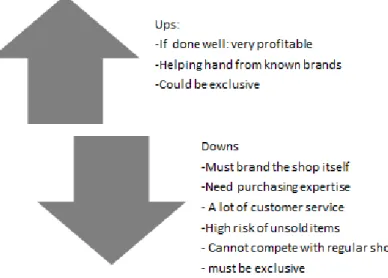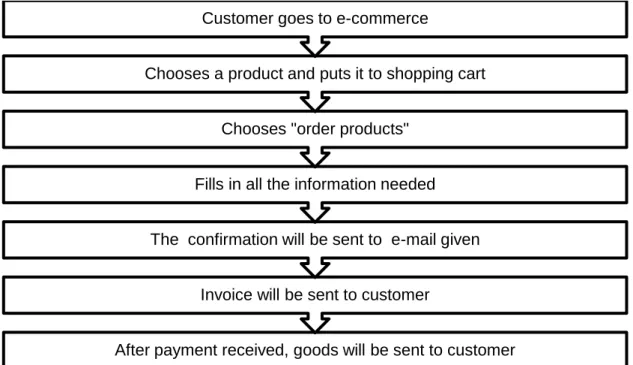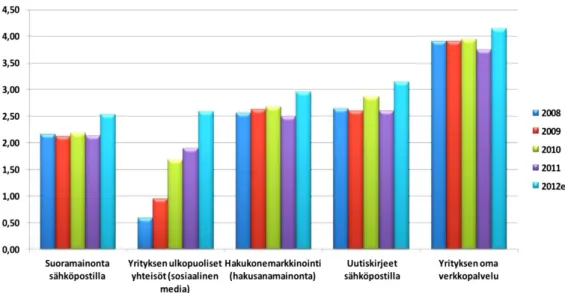The e-business environment is different from other business environments, so it is important to understand the terms and rules when planning an e-business. The digital marketing part talks about digital marketing channels and tools that differ from classic marketing.
Background of the study
The author of this thesis works in a non-profit organization called the Finnish Seamen's Mission as a manager of fundraising. The ultimate goal of this thesis is to create a strategic development plan for the e-commerce of the Finnish seamen's mission.
Objective of the study and limitations
There is potential in the e-commerce sector, but it also requires a lot of work and effort. Due to this, the theory presents many different types of strategy tools and also introduces digital marketing methods used in the development plan.
Research question
It concentrates on customers in e-commerce and mainly on potential customers, because many of those who already support the Finnish Seamen's Mission do not like to shop online. This issue is relevant for the Finnish Seamen's Mission because, as already mentioned, it has decided to develop its fundraising, and e-commerce is one part of this development.
Research methods
Evidence for the case studies can come from six sources: documents, records, interviews, direct observation, participant observation, and physical artifacts. The e-commerce plan is built by analyzing both the external and internal environment of the case organization, specifying strategies, identifying development steps and marketing objectives, and determining actions.

Structure of the study
This thesis has been carried out by reading and reflecting on the literature, observing the current situation and looking at annual reports, sales charts of the old e-commerce and other sources, conducting competitive analysis and making a plan based on these steps. . This chapter presents the non-profit environment, introduces the case company of the Finnish Seaman Mission, and explains the e-commerce background at the Finnish Seaman Mission.
Non-profit organization
Special features on non-profits
Another distinctive feature is that non-profit organizations offer ways of thinking (not concrete things) and not so much concrete products. As mentioned earlier in non-profit organizations, the financial goal is not the most important indicator.
Non-profits in Finland
Non-profit organizations often receive their income from clients other than those who are the target group of their work. In many cases, there are many people who need the help, support, and services of nonprofit organizations, and due to a lack of resources, nonprofit organizations cannot serve everyone who needs them.
The Finnish Seamen’s Mission
The Finnish Seamen's Mission works in close cooperation with the Evangelical Lutheran Church of Finland, but it is a separate organization. As the figures tell, the Finnish Seamen's Mission has financial challenges that need to be solved.
E-commerce in the Finnish Seamen’s Mission
The Finnish Seamen's Mission has made a decision to improve fundraising and they have hired the author of this thesis to work on fundraising. Products sold were a piece of jewelry (branded the Finnish sailors' mission), commemorative cards, maps and seasonal products.

Basics on strategy and strategic process
The first definition means that a strategy is a structured and pre-planned process that has a beginning and an end and people responsible for it. Ultimately, strategy tries to achieve the company's mission, which is not an end in itself, but a process of change.

Strategic planning in non-profits
The fourth phase is exploring the environment outside the organization to identify the opportunities and threats of the organization. In other words, strategic planning helps to create consensus and clarity about the mission, values and goals of the organization.
Strategy tools
- SWOT-analysis
- Porter’s Five Forces
- The Boston Consulting Group Matrix
- Critical success factors
The Boston Consulting Group matrix (BCG Matrix) maps products onto a two-dimensional matrix. The Boston Consulting Group introduced the model in the form of a simple two-dimensional matrix.

E-commerce strategy
Therefore, some analysis of the situation should be done before making any strategic decisions for the e-commerce of the mission of Finnish seafarers. On the front page of the e-shop, there is a call to action "you help with your purchase". The Finnish naval mission already used e-commerce at the beginning of the process.
Also, the ordering process should be developed so that it will add profits from the Finnish sailors' mission. In the case of the Finnish sailor mission, it is recommended to use flexible modifier and phrase match depending on the popularity of the keyword used.

E-commerce environment
Basic e-commerce requirements
Finnish Competition and Consumer Authority has introduced a business e-commerce checklist, which must be mentioned when doing business on the Internet. Product information must follow the legal requirements and also order confirmation must be given to consumer. Customer service information should also be clearly presented and also state the opening hours.
The chosen customer segment must be large enough to have customers in the e-commerce and to be able to make a profit. When planning e-commerce, it must also be considered how it will be marketed and by marketing adding the reputation of the e-commerce.
Digital marketing
- Search engine optimization
- Pay-per-click (PPC) search marketing
- Social media
- Facebook advertising
- E-mail marketing
- Metrics
There are two options for gaining visibility in search engines: paid keyword advertising or search engine optimization. Two things make search engine optimization an outstanding marketing method. The idea behind search engine optimization is to help search engines bring people who are interested in a particular topic to a business page.
The search engine optimization is not a single project; rather, it should be one part of the web process. Search engine changes are based on evaluation, so results can be improved by following the actions.

Competitor analysis
In the second category, there are still seasonal items (Christmas cards) at the top of the page, also in summer. HelsinkiMissio has no call to action at all on the main page of their e-commerce. The goal of the Finnish Red Cross is to help those who need it most both in Finland and abroad.
The Finnish Red Cross is one of the 187 member organizations of the International Federation of Red Cross and Red Crescent Societies (IFRC). The e-commerce of the Finnish Red Cross can be easily accessed from their homepage, but also has the direct address http://www.punaisenristinkauppa.fi/. It seems to be a separate page.

Porter’s Five Forces model in e-commerce markets
Not all of the advantages found could be replicated for the Seamen's Mission e-commerce, for example, the possibility of bundling donations and products needs to be explored more. First, it is necessary to change some suppliers or at least the ordered products. Suppliers need to understand the charitable aspect of the Finnish sailors' mission, and prices should be re-examined.
New suppliers must also understand the charity aspect and indeed all prices must be tendered. The Finnish Naval Mission already has some existing e-commerce customers, and of course these customers need to be retained, while informing them more about the work that the Finnish Naval Mission is doing (the reason why the money is needed).
Strategic decisions
Powerful customers will lower prices or demand more value in the product, capturing more of the value for themselves. The Finnish Seamen's Mission already has some existing customers in e-commerce and those customers must of course be retained, but at the same time they need to be more informed about the work that the Finnish Seamen's Mission is doing. The e-commerce's mission is to support fundraising and be a profitable thrift store that makes buyer and seller feel good.
The mission was chosen because the fundraising development is part of the company's strategy and also fundraising must have different types of support options. The estimated cost of the store in the first year is higher than the coming years, so it will eat some profits.

Development points
The ideal product quantity for the Finnish seamen's mission e-commerce would be between 20-30 products, and the product portfolio is based on existing products, because the risk will be lower in this way. Advertising in the Finnish seamen's mission's own magazine is also important in the future in order to reach this group. If one uses this segmentation in marketing, it should be done as an experimental test to be able to explore little by little what is the best segment for the Finnish sailor mission.
The Finnish Seaman Mission has to look for the cheapest way to add the payment methods, because it is a charity shop after all. The shop should clearly promote that it is a charity shop, using all the income for the Seamansending's operational work to help and support people living abroad.

Marketing actions
Basically, the idea behind A/B testing is to create two versions of e-commerce and test which one generates better conversion. Also in Google's AdWords, the main metric should be the conversion, because the goal of the advertising is to receive new customers. Campaign monitor is a basic tool which is suitable for the use of the Finnish sailor mission because the price is based on the volume of the email sent (€0.02 per email) and basic fee (€5 per campaign).
To be able to understand what is the e-commerce situation of the Finnish Seafarers' Mission after they have implemented the development steps and what are their CSFs (critical success factors), a SWOT analysis of the developed e-commerce is made . The shop was only marketed in the magazine of the Finnish Seamen's Mission, and due to the small circulation of the magazine it was not the best marketing channel. E-commerce should not be an operation that is not attached to any of the company's existing strategies.
E-commerce will probably have losses at the beginning of development, but without development it will never succeed.




